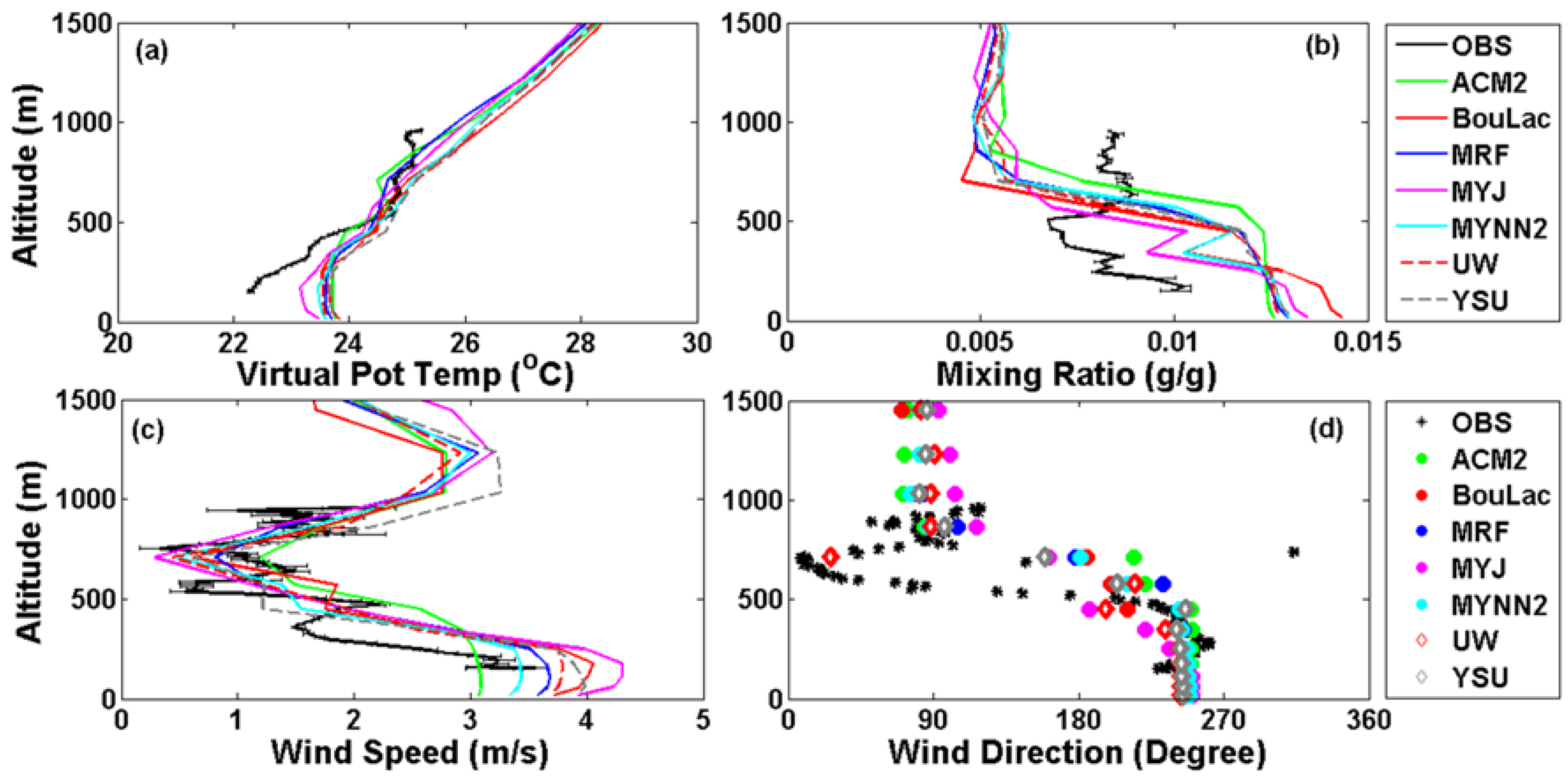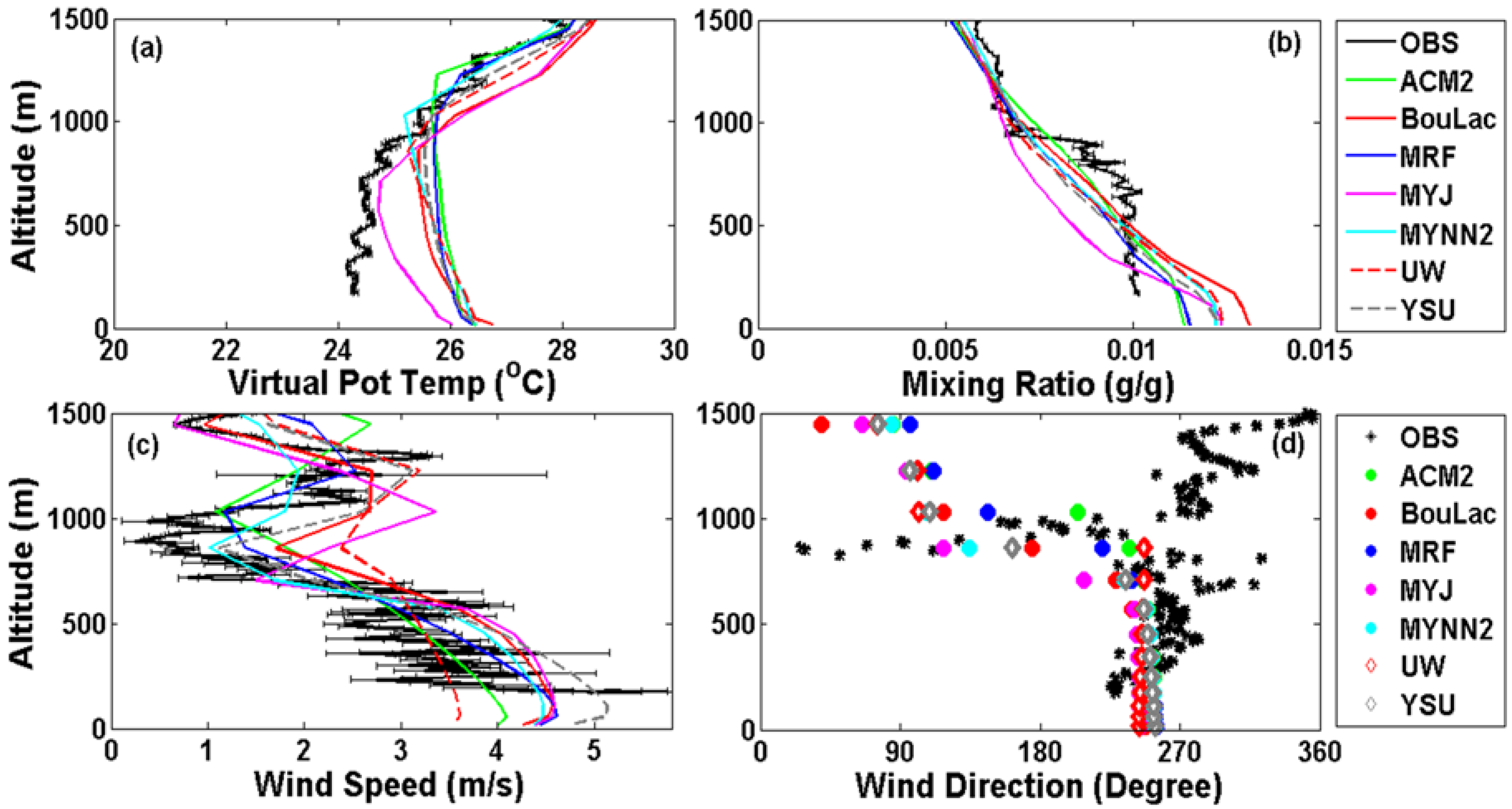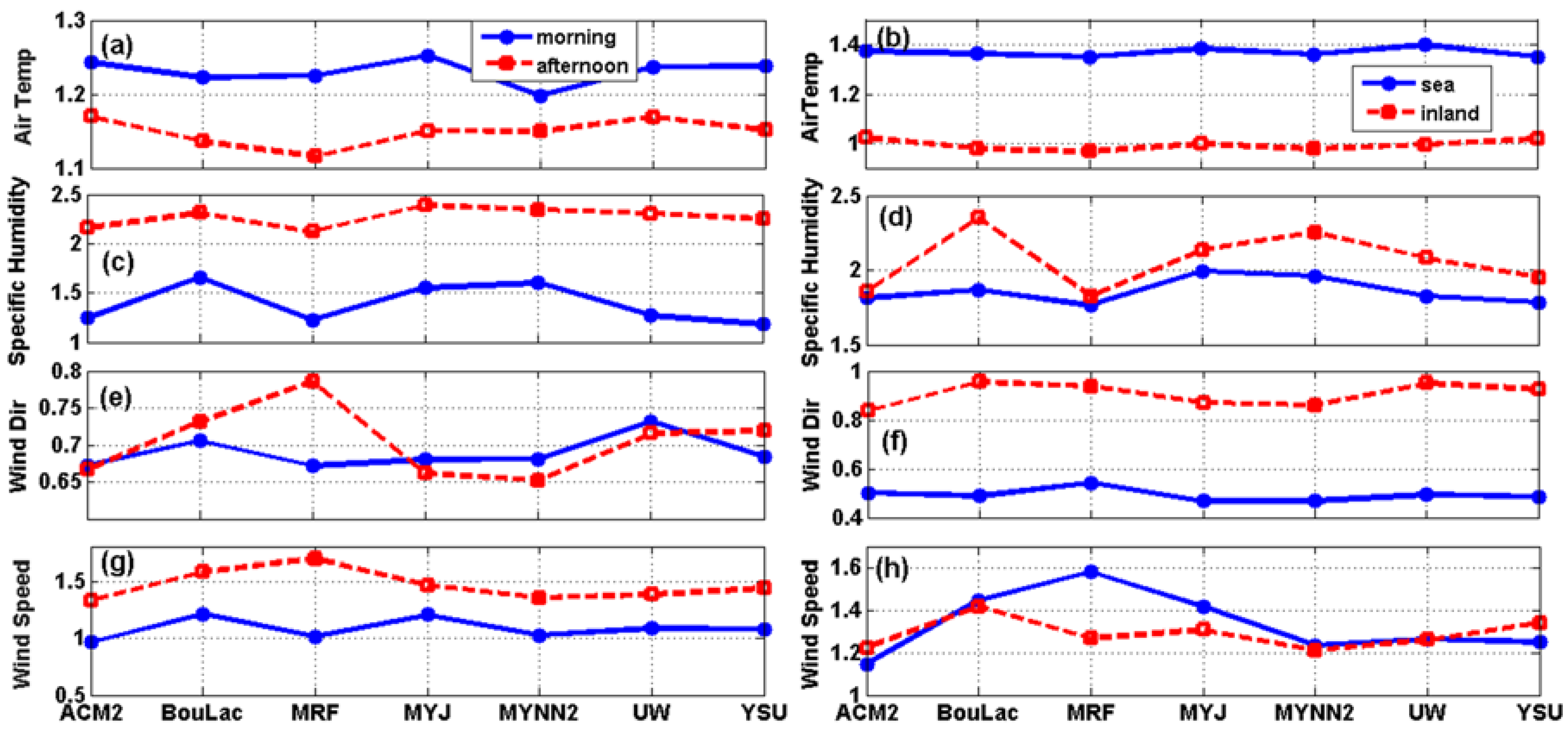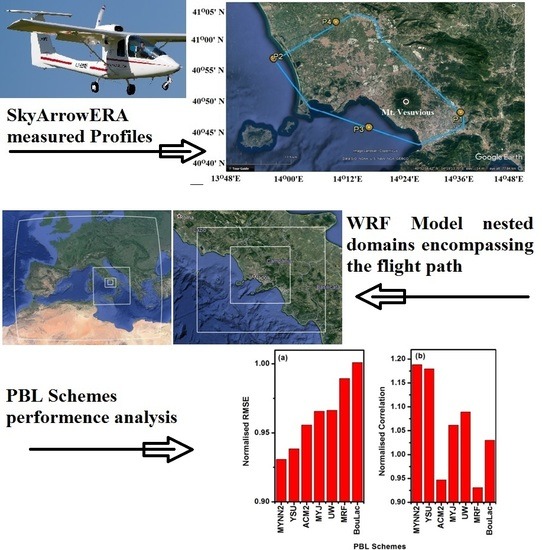Performance Analysis of Planetary Boundary Layer Parameterization Schemes in WRF Modeling Set Up over Southern Italy
Abstract
:1. Introduction
2. Materials and Methods
2.1. Study Area
2.2. Aircraft Data
2.3. Meteorological Model
2.3.1. The Asymmetrical Convective Model Version 2 (ACM2) Scheme
2.3.2. Medium-Range Forecast (MRF) Scheme
2.3.3. Yonsei University (YSU) Scheme
2.3.4. Mellor–Yamada–Janjic (MYJ) Scheme
2.3.5. Mellor–Yamada–Nakanishi–Niino Level 2.5 (MYNN2) Scheme
2.3.6. Bougeault–Lacarrere (BouLac) Scheme
2.3.7. University of Washington (UW) Scheme
2.4. Model Performance Assessment
3. Results and Discussion
3.1. Synoptic and Local Circulation Conditions during Flights
3.2. Vertical Profiles of Air Temperature, Specific Humidity, Wind Speed, and Direction
3.3. Spatial and Temporal Assessment of Model PBL Schemes
3.4. Comparison of Observed and Modeled PBL Height
4. Conclusions
Author Contributions
Funding
Acknowledgments
Conflicts of Interest
References
- Schmale, J.; Schindell, D.; von Schneidemesser, E.; Chabay, I.; Lawrence, M. Air Pollution: Clean up our skies. Nature 2014, 515, 335–337. [Google Scholar] [CrossRef] [PubMed]
- Zhang, Y.; Sartelet, K.; Wu, S.Y.; Seigneur, C. Application of WRF/Chem-MADRID and WRF/Polyphemus in Europe—Part 1: Model description, evaluation of meteorological predictions, and aerosol-meteorology interactions. Atmos. Chem. Phys. 2013, 13, 6807–6843. [Google Scholar] [CrossRef]
- Angevine, W.M.; Eddington, L.; Durkee, K.; Fairall, C.; Bianco, L.; Brioude, J. Meteorological Model Evaluation for CalNex 2010. Mon. Weather Rev. 2012, 140, 3885–3906. [Google Scholar] [CrossRef]
- Kim, Y.; Sartelet, K.; Raut, J.C.; Chazette, P. Evaluation of the Weather Research and Forecast/Urban Model over Greater Paris. Bound.-Layer Meteorol. 2013, 149, 105–132. [Google Scholar] [CrossRef]
- Govardhan, G.; Nanjundiah, R.S.; Satheesh, S.K.; Krishnamoorthy, K.; Kotamarthi, V.R. Performance of WRF-Chem over Indian region: Comparison with measurements. J. Earth Syst. Sci. 2015, 124, 875–896. [Google Scholar] [CrossRef]
- Arunachalam, S.; Holland, A.; Do, B.; Abraczinskas, M. A quantitative assessment of the influence of grid resolution on predictions of future year air quality in North Carolina, USA. Atmos. Environ. 2006, 40, 5010–5026. [Google Scholar] [CrossRef]
- Borge, R.; Alexandrov, V.; del Vas, J.J.; Lumbreras, J.; Rodrıguez, E. A comprehensive sensitivity analysis of the WRF model for air quality applications over the Iberian Peninsula. Atmos. Environ. 2008, 42, 8560–8574. [Google Scholar] [CrossRef] [Green Version]
- Misenis, C.; Zhang, Y. An examination of sensitivity of WRF/Chem predictions to physical parameterizations, horizontal grid spacing, and nesting options. Atmos. Res. 2010, 97, 315–334. [Google Scholar] [CrossRef]
- Skamarock, W.C.; Klemp, J.B.; Dudhia, J.; Gill, D.O.; Barker, D.M.; Duda, M.G.; Huang, X.Y.; Wang, W.; Powers, J.G. A Description of the Advanced Research WRF Version 3; National Centre of Atmospheric Research: Boulder, CO, USA, 2008. [Google Scholar]
- Yver, C.E.; Graven, H.D.; Lucas, D.D.; Cameron-Smith, P.J.; Keeling, R.F.; Weiss, R.F. Evaluating transport in the WRF model along the California coast. Atmos. Chem. Phys. 2013, 13, 1837–1852. [Google Scholar] [CrossRef] [Green Version]
- Finardi, S.; Agrillo, G.; Baraldi, R.; Calori, G.; Carlucci, P.; Ciccioli, P.; D’Allura, A.; Gasbarra, D.; Gioli, B.; Magliulo, V.; et al. Atmosphericdynamics and ozone cycle during seabreeze in a Mediterranean complex urbanized coastal site. J. Appl. Meteorol. Climatol. 2018, 57, 1083–1099. [Google Scholar] [CrossRef]
- Silibello, C.; Calori, G.; Brusasca, G.; Giudici, A.; Angelino, E.; Fossati, G.; Peroni, E.; Buganza, E. Modelling of PM10 Concentrations over Milano Urban Area Using Two Aerosol Modules. Environ. Model. Softw. 2008, 23, 333–343. [Google Scholar] [CrossRef]
- Kukkonen, J.; Olsson, T.; Schultz, M.; Baklanov, A.; Klein, T.; Miranda, I.; Monteiro, A.; Hirtl, M.; Tarvainen, V.; Boy, M.; et al. A review of operational, regional-scale, chemicalweatherforecastingmodels in Europe. Atmos. Chem. Phys. 2012, 12, 1–87. [Google Scholar] [CrossRef] [Green Version]
- Gioli, B.; Miglietta, F.; Vaccari, F.P.; Zaldei, A.; DeMartino, B. The Sky Arrow ERA, an innovative airborne platform to monitor mass, momentum and energy exchange of ecosystems. Ann. Geophys. 2006, 49, 109–116. [Google Scholar]
- Zhong, S.; In, H.; Clements, C. Impact of turbulence, land surface, and radiation parameterizations on simulated boundary layer properties in a coastal environment. J. Geophys. Res. 2007, 112. [Google Scholar] [CrossRef] [Green Version]
- Shin, H.H.; Hong, S.Y. Intercomparison of Planetary Boundary-Layer Parametrizations in the WRF Model for a Single Day from CASES-99. Bound.-Layer Meteorol. 2011, 139, 261–281. [Google Scholar] [CrossRef]
- Mohan, M.; Bhati, S. Analysis of WRF Model Performance over Subtropical Region of Delhi, India. Adv. Meteorol. 2011, 2011, 621235. [Google Scholar] [CrossRef]
- Xie, B.; Fung, J.C.H.; Chan, A.; Lau, A. Evaluation of nonlocal and local planetary boundary layer schemes in the WRF model. J. Geophys. Res. 2012, 117, D12103. [Google Scholar] [CrossRef]
- Madala, S.; Satyanarayana, A.N.V.; Srinivas, C.V.; Kumar, M. Mesoscale atmospheric flow field simulations for air quality modeling over complex terrain region of Ranchi in eastern India using WRF. Atmos. Environ. 2015, 107, 315–328. [Google Scholar] [CrossRef]
- Madala, S.; Satyanarayana, A.N.V.; Srinivas, C.V.; Tyagi, B. Performance Evaluation of PBL Schemes of WRF-ARW Model in the Simulating Thermo-Dynamical Structure of Pre-monsoon convective Episodes over Kharagpur using STORM Data Sets. Pure Appl. Geophys. 2016, 173, 1803–1827. [Google Scholar] [CrossRef]
- Banks, R.F.; Tiana-Alsina, J.; Rocadenbosch, F.; Baldasano, J.M. Performance Evaluation of the Boundary-Layer Height from Lidar and the Weather Research and Forecasting Model at an Urban Coastal Site in the North-East Iberian Peninsula. Bound.-Layer Meteorol. 2015, 157, 265–292. [Google Scholar] [CrossRef] [Green Version]
- Banks, R.F.; Tiana-Alsina, J.; Baldasano, J.M.; Rocadenbosch, F.; Papayannis, A.; Solomos, S.; Tzanis, C.G. Sensitivity of boundary-layer variables to PBL schemes in the WRF model based on surface meteorological observations, lidar, and radiosondes during the HygrA-CD campaign. Atmos. Res. 2016, 176–177, 185–201. [Google Scholar] [CrossRef]
- Li, X.; Pu, Z. Sensitivity of numerical simulation of early rapid intensification of hurricane Emily (2005) to cloud microphysical and planetary boundary layer parameterizations. Mon. Weather Rev. 2008, 136, 4819–4838. [Google Scholar] [CrossRef]
- Hu, X.M.; Nielson-Gammon, J.W.; Zhang, F. Evaluation of three Planetary Boundary Layer schemes in the WRF model. J. Appl. Meteorol. Climatol. 2010, 49, 1831–1844. [Google Scholar] [CrossRef]
- Garcia-Diez, M.; Fernandez, J.; Fita, L.; Yague, C. Seasonal dependence of WRF model biases and sensitivity to PBL schemes over Europe. Q. J. R. Meteorol. Soc. 2013, 139, 501–514. [Google Scholar] [CrossRef]
- Cohen, A.E.; Cavallo, S.M.; Coniglio, M.C.; Brooks, H.E. A review of planetary boundary layer parameterization schemes and their sensitivity in simulating southeastern U.S. cold season severe weather environments. Weather Forecast. 2015, 30, 591–612. [Google Scholar] [CrossRef]
- Qian, Y.; Yan, H.; Berg, L.; Hagos, S.; Feng, Z.; Yang, B.; Huang, M. Assessing impacts of PBL and surface layer schemes in simulating the surface-atmosphere interactions and precipitation over the tropical ocean using observations from AMIE/DYNAMO. J. Clim. 2016, 29, 8191–8210. [Google Scholar] [CrossRef]
- Demographic Balance Data. 2014. Available online: http://demo.istat.it (accessed on 22 June 2018).
- Martuzzi, M.; Mitis, F.; Bianchi, F.; Minichilli, F.; Comba, P.; Fazzo, L. Cancer mortality and congenital anomalies in a region of Italy with intense environmental pressure due to waste. Occup. Environ. Med. 2009, 66, 725–732. [Google Scholar] [CrossRef] [PubMed] [Green Version]
- Fazzo, L.; de Santis, M.; Mitis, F.; Benedetti, M.; Martuzzi, M.; Comba, P.; Fusco, M. Ecological studies of cancer incidence in an area interested by dumping waste sites in Campania (Italy). Ann. Ist. Super. Sanita 2011, 47, 181–191. [Google Scholar] [PubMed]
- Pirastu, R.; Zona, A.; Ancona, C.; Bruno, C.; Fano, V.; Fazzo, L.; Iavarone, I.; Minichilli, F.; Mitis, F.; Pasetto, R.; et al. Mortality results in SENTIERI Project. Epidemiol. Prev. 2011, 35, 29–152. [Google Scholar] [PubMed]
- Triassi, M.; Alfano, R.; Illario, M.; Nardone, A.; Caporale, O.; Montuori, P. Environmental Pollution from Illegal Waste Disposal and Health Effects: A Review on the “Triangle of Death”. Int. J. Environ. Res. Public Health 2015, 12, 1216–1236. [Google Scholar] [CrossRef] [PubMed] [Green Version]
- Barone, G.; D’Ambra, P.; di Serafino, D.; Giunta, G.; Murli, A.; Riccio, A. Application of a parallel photochemical air quality model to the Campania region (southern Italy). Environ. Model. Softw. 2000, 15, 503–511. [Google Scholar] [CrossRef]
- Vellinga, O.S.; Dobosy, R.J.; Dumas, E.J.; Gioli, B.; Elbers, J.A.; Hutjes, R.W.A. Calibration and quality assurance of flux observations from a small research aircraft. J. Atmos. Ocean. Technol. 2013, 30, 161–181. [Google Scholar] [CrossRef]
- Dobosy, R.; Dumas, E.J.; Senn, D.L.; Baker, B.; Seyres, D.S.; Witinski, M.F.; Healy, C.; Munster, J.; Anderson, J.G. Calibration and quality assurance of an airborne turbulence probe in an aeronautical wind tunnel. J. Atmos. Ocean. Technol. 2013, 30, 182–196. [Google Scholar] [CrossRef]
- WRF User Manual, 2015 ARW Version 3 Modeling System User’s Guide. January 2015. Available online: http://www2.mmm.ucar.edu/wrf/users/docs/user_guide_V3.5/ARWUsersGuideV3.pdf (accessed on 22 June 2018).
- Vogelezang, D.H.P.; Holtslag, A.A.M. Evaluation and model impacts of alternative boundary-layer height formulations. Bound.-Layer Meteorol. 1996, 81, 245–269. [Google Scholar] [CrossRef]
- Pleim, J.E. A combined local and non-local closure model for the atmospheric boundary layer. Part 1: Model description and testing. J. Appl. Meteorol. Climatol. 2007, 46, 1383–1395. [Google Scholar] [CrossRef]
- Blackadar, A.K. Modeling pollutant transfer during daytime convection. In Preprints Fourth Symposium on Atmospheric Turbulence, Diffusion, and Air Quality; American Meteorological Society: Reno, NV, USA, 1978; pp. 443–447. [Google Scholar]
- Hong, S.Y.; Pan, H.L. Nonlocal boundary layer vertical diffusion in a medium-range forecast model. Mon. Weather Rev. 1996, 124, 2322–2339. [Google Scholar] [CrossRef]
- Troen, L.; Mahrt, L. A simple model of the atmospheric boundary layer: Sensitivity to surface evaporation. Bound.-Layer Meteorol. 1986, 37, 129–148. [Google Scholar] [CrossRef]
- Wyngaard, J.C.; Brost, R.A. Top-down and bottom-up diffusion of a scalar in the convective boundary layer. J. Atmos. Sci. 1984, 41, 102–112. [Google Scholar] [CrossRef]
- Stull, R.B. Review of non-local mixing in turbulent atmospheres: Transilient turbulence theory. Bound.-Layer Meteorol. 1993, 62, 21–96. [Google Scholar] [CrossRef]
- Hong, S.Y.; Noh, Y.; Dudhia, J. A new vertical diffusion package with an explicit treatment of entrainment processes. Mon. Weather Rev. 2006, 134, 2318–2341. [Google Scholar] [CrossRef]
- Lobocki, L. Mellor-Yamada simplified second-order closure models: Analysis and application of the generalized von Karman local similarity hypothesis. Bound.-Layer Meteorol. 1992, 59, 83–109. [Google Scholar] [CrossRef]
- Janjic, Z. Nonsingular Implementation of the Mellor-Yamada Level 2.5 Scheme in the NCEP Meso Model; NCEP Office Note, No. 437; National Centers for Environmental Prediction: College Park, MD, USA, 2002; p. 61.
- Janjic, Z. The step-mountain coordinate: Physical package. Mon. Weather Rev. 1990, 118, 1429–1443. [Google Scholar] [CrossRef]
- Coniglio, M.C.; Correia, J., Jr.; Marsh, P.T.; Kong, F. Verification of convection-allowing WRF model forecasts of the planetary boundary layer using sounding observations. Weather Forecast. 2013, 28, 842–862. [Google Scholar] [CrossRef]
- Mellor, G.L.; Yamada, T. A hierarchy of turbulence closure models for planetary boundary layers. J. Atmos. Sci. 1974, 31, 1791–1806. [Google Scholar] [CrossRef]
- Mellor, G.L.; Yamada, T. Development of a turbulence closure model for geophysical fluid problems. Rev. Geophys. Space Phys. 1982, 20, 851–875. [Google Scholar] [CrossRef]
- Nakanishi, M. Improvement of the Mellor–Yamada turbulence closure model based on large-eddy simulation data. Bound.-Layer Meteorol. 2001, 99, 349–378. [Google Scholar] [CrossRef]
- Nakanishi, M.; Niino, H. An improved Mellor–Yamada level-3 model with condensation physics: Its design and verification. Bound.-Layer Meteorol. 2004, 112, 1–31. [Google Scholar] [CrossRef]
- Nakanishi, M.; Niino, H. Development of an improved turbulence closure model for the atmospheric boundary layer. J. Meteorol. Soc. Jpn. 2009, 87, 895–912. [Google Scholar] [CrossRef]
- Bougeault, P.; Lacarrere, P. Parameterization of orography-induced turbulence in amesobeta-scale model. Mon. Weather Rev. 1989, 117, 1872–1890. [Google Scholar] [CrossRef]
- Martilli, A.; Clappier, A.; Rotach, M.W. An urban surface exchange parameterisation for mesoscale models. Bound.-Layer Meteorol. 2002, 104, 261–304. [Google Scholar] [CrossRef]
- Grenier, H.; Bretherton, C.S. A moist PBL parameterization for large-scale models and its application to subtropical cloud-topped marine boundary layers. Mon. Weather Rev. 2001, 129, 357–377. [Google Scholar] [CrossRef]
- Bretherton, C.; Park, S. A new moist turbulence parameterization in the community atmosphere model. J. Clim. 2009, 22, 3422–3448. [Google Scholar] [CrossRef]
- Gent, P.R.; Danabasoglu, G.; Donner, L.J.; Holland, M.M.; Hunke, E.C.; Jayne, S.R.; Lawrence, D.M.; Neale, R.B.; Rasch, P.J.; Vertenstein, M.; et al. The Community Climate System Model Version 4. J. Clim. 2011, 24, 4973–4991. [Google Scholar] [CrossRef] [Green Version]
- Wyngaard, J.C. Toward Numerical Modeling in the “Terra Incognita”. J. Atmos. Sci. 2004, 61, 1816–1826. [Google Scholar] [CrossRef]
- Ito, J.; Niino, H.; Nakanishi, M.; Moeng, C. An Extension of the Mellor–Yamada Model to the TerraIncognita Zone for Dry Convective Mixed Layersin the Free Convection Regime. Bound.-Layer Meteorol. 2015, 157, 23–43. [Google Scholar] [CrossRef]
- Skamarock, W.C. Evaluating Mesoscale NWP Models Using Kinetic Energy Spectra. Mon. Weather Rev. 2004, 132, 3019–3032. [Google Scholar] [CrossRef]
- Wang, X.Y.; Wang, K.C. Estimation of atmospheric mixing layer height from radiosonde data. Atmos. Meas. Tech. 2014, 7, 1701–1709. [Google Scholar] [CrossRef] [Green Version]
- Seidel, D.J.; Ao, C.O.; Li, K. Estimating climatological planetary boundary layer heights from radiosonde observations: Comparison of methods and uncertainty analysis. J. Geophys. Res. 2010, 115. [Google Scholar] [CrossRef] [Green Version]
- Sorensen, J.H. Sensitivity of the DERMA long-range Gaussian dispersion model to meteorological input and diffusion parameters. Atmos. Environ. 1998, 32, 4195–4206. [Google Scholar] [CrossRef]
- Gioli, B.; Gualtieri, G.; Busillo, C.; Calastrini, F.; Gozzini, B.; Miglietta, F. Aircraft wind measurements to assess a coupled WRF-CALMET mesoscale system. Meteorol. Appl. 2014, 21, 117–128. [Google Scholar] [CrossRef]
- Thunis, P.; Georgieva, E.; Galmarini, S. A Procedure for Air Quality Models Benchmarking, FAIRMODE Report Version 2. 2011. Available online: http://fairmode.jrc.ec.europa.eu/ (accessed on 22 June 2018).
- Enhanced Meteorological Modeling and Performance Evaluation for Two Texas Ozone Episodes. Available online: https://www.tceq.texas.gov/assets/public/implementation/air/am/contracts/reports/mm/EnhancedMetModelingAndPerformanceEvaluation.pdf (accessed on 22 June 2018).
- Yuan, X.; Wood, E.F. On the clustering of climate models in ensemble seasonal forecasting. Geophys. Res. Lett. 2012, 39. [Google Scholar] [CrossRef] [Green Version]













| Serial Number | Instrument | Parameters Measured | Accuracy |
|---|---|---|---|
| 75H 0590 | LICOR-7500-LI-COR/LI-COR Biosciences, Lincoln, NE, USA | CO2 and H–O densities of air | Within 1% of reading for CO2 and within 2% of reading for H2O |
| ATDD03-3 | Best Aircraft Turbulence (BAT) probe/NOAA, Silver Spring, MD, USA; Airborne Research Australia, Adelaide, Austrilia | 3D wind speed (u, v, w) with respect to aircraft | The ratio of standard deviation of w ~5% |
| LD90-3300HR | Riegl Laser Altimeter LD90-3/RIEGL Laser Measurement Systems GmbH, Horn, Austria | Aircraft flying height from the ground | Typically 0.5 m at highest range and 10 cm at minimum range |
| CM1480 | C-MIGITS (Accelerometer)/Systron Donner Inertial, Concord, CA, USA | Position, velocity, and attitude information | Position (Spherical Error Probable-SEP): 3.9 m, Velocity (1 sigma, horiz/vert): 0.1/0.1 m/s, Pitch and roll (1 sigma): 1.0 mrad, Time mark output 1 pps: 1 microsecond, Heading (1 sigma, in motion): 1.5 mrad |
| 2003-004 | GPS OEM4 Family/Novatel, Calgary, AB, Canada | Position, velocity, altitude ASL (Above Sea Level) and GPS time | Position accuracy 1.8 m, velocity accuracy 0.03 RMS, time accuracy 20 ns RMS |
| Q03045 | LI-190SA Photosynthetically Active Radiation (PAR)-Radiometer/LI-COR Biosciences, Lincoln, NE, USA | Photosynthetic photon flux density (PPFD) | Sensitivity: Typically 5 μA to 10 μA per 1000 μmol s−1 m−2 Linearity: Maximum deviation of 1% up to 10,000 μmol s−1 m−2 |
| Serial Number | Flight | Date and Time | Profiles |
|---|---|---|---|
| 1 | Flight 1 | 7 October 2014, 08:39–10:58 UTC | 1 (09:05 UTC), 2 (09:46 UTC), 3 (10:23 UTC), 4 (11:12 UTC) |
| 2 | Flight 2 | 7 October 2014, 12:38–16:56 UTC | 1 (14:42 UTC), 2 (13:50 UTC), 3 (13:16 UTC), 4 (14:12 UTC) |
| 3 | Flight 3 | 8 October 2014, 12:47–14:46 UTC | 1 (13:09 UTC), 2 (14:11 UTC), 3 (14:39 UTC), 4 (13:45 UTC) |
| 4 | Flight 4 | 9 October 2014, 08:39–10:37 UTC | 1 (08:56 UTC), 2 (09:36 UTC), 3 (10:06 UTC), 4 (10:55 UTC) |
| 5 | Flight 5 | 9 October 2014, 12:09–14:24 UTC | 1(14:19 UTC), 2 (13:17 UTC), 3 (12:46 UTC), 4 (13:40 UTC) |
| Dynamics | Non Hydrostatic |
|---|---|
| Data | NCEP GFS |
| Interval | 3 h |
| Gridsize and Resolution | Domain1: (80×57) × 34: 27km × 27km Domain2: (95× 95) ×34: 9km × 9km Domain3: (69× 69) × 34: 3km × 3km Domain4: (69× 69) × 34: 1km × 1km |
| Map projection | Lambert Conformal |
| Horizontalgrid system | Arakawa-C grid |
| Integration time step | 225 s |
| Vertical coordinates | Terrain-following hydrostatic pressure vertical co-ordinate with 34 vertical levels |
| Time integrationscheme | Third order Runga–Kutta Scheme |
| Spatialdifferencingscheme | Sixth order center differencing |
| Land surface option | Noah land surface scheme |
| Microphysics | WSM six-class graupelscheme |
| Shortwaveradiation | (old) Goddardshortwavescheme |
| Longwaveradiation | Rapid Radiative Transfer Model (RRTM) scheme |
| Cumulus parameterization | Kain–Fritsch scheme in Domain 1 and 2 and no scheme in Domain 3 and 4 |
| Surface layer physics | Monin–Obukhovsimilaritytheory |
| PBL schemes tested in present work | ACM2, BouLac, MRF, MYJ, MYNN2, UW, YSU |
| Schemes | ACM2 | BouLac | MRF | MYJ | MYNN2 | UW | YSU | OBS |
|---|---|---|---|---|---|---|---|---|
| Profiles | Flight 1: 7 October 2014, 08:39–10:58 UTC | |||||||
| p1 | 1047 | 1040 | 912 | 995 | 1000 | 889 | 983 | 980 |
| p2 | 586 | 671 | 601 | 628 | 528 | 439 | 517 | 700 |
| p3 | 702 | 715 | 593 | 671 | 494 | 518 | 568 | 750 |
| p4 | 1441 | 1390 | 1398 | 1435 | 1323 | 1392 | 1387 | - |
| Flight 2: 7 October 2014, 12:38–16:56 UTC | ||||||||
| p1 | 1135 | 879 | 925 | 686 | 751 | 682 | 848 | - |
| p2 | 770 | 630 | 871 | 743 | 762 | 694 | 773 | 450 |
| p3 | 888 | 540 | 788 | 638 | 702 | 439 | 640 | 600 |
| p4 | 1331 | 1142 | 1225 | 1017 | 1151 | 1159 | 1195 | - |
| Flight 3: 8 October 2014, 12:47–14:46 UTC | ||||||||
| p1 | 1002 | 901 | 850 | 744 | 705 | 830 | 949 | 1000 |
| p2 | 464 | 390 | 382 | 356 | 364 | 425 | 418 | 360 |
| p3 | 365 | 319 | 320 | 312 | 297 | 284 | 309 | 200 |
| p4 | 972 | 859 | 799 | 790 | 877 | 1016 | 856 | 830 |
| Flight 4: 9 October 2014, 08:39–10:37 UTC | ||||||||
| p1 | 421 | 445 | 302 | 392 | 347 | 403 | 390 | 400 |
| p2 | 226 | 200 | 142 | 106 | 144 | 129 | 135 | 480 |
| p3 | 128 | 183 | 161 | 145 | 141 | 138 | 147 | 500 |
| p4 | 774 | 923 | 765 | 902 | 770 | 816 | 862 | 820 |
| Flight 5: 9 October 2014, 12:09–14:24 UTC | ||||||||
| p1 | 654 | 653 | 441 | 472 | 381 | 557 | 449 | 1005 |
| p2 | 268 | 198 | 240 | 203 | 201 | 190 | 204 | 400 |
| p3 | 186 | 169 | 184 | 132 | 161 | 131 | 188 | 310 |
| p4 | 770 | 754 | 614 | 446 | 538 | 670 | 570 | 680 |
© 2018 by the authors. Licensee MDPI, Basel, Switzerland. This article is an open access article distributed under the terms and conditions of the Creative Commons Attribution (CC BY) license (http://creativecommons.org/licenses/by/4.0/).
Share and Cite
Tyagi, B.; Magliulo, V.; Finardi, S.; Gasbarra, D.; Carlucci, P.; Toscano, P.; Zaldei, A.; Riccio, A.; Calori, G.; D’Allura, A.; et al. Performance Analysis of Planetary Boundary Layer Parameterization Schemes in WRF Modeling Set Up over Southern Italy. Atmosphere 2018, 9, 272. https://doi.org/10.3390/atmos9070272
Tyagi B, Magliulo V, Finardi S, Gasbarra D, Carlucci P, Toscano P, Zaldei A, Riccio A, Calori G, D’Allura A, et al. Performance Analysis of Planetary Boundary Layer Parameterization Schemes in WRF Modeling Set Up over Southern Italy. Atmosphere. 2018; 9(7):272. https://doi.org/10.3390/atmos9070272
Chicago/Turabian StyleTyagi, Bhishma, Vincenzo Magliulo, Sandro Finardi, Daniele Gasbarra, Pantaleone Carlucci, Piero Toscano, Alessandro Zaldei, Angelo Riccio, Giuseppe Calori, Alessio D’Allura, and et al. 2018. "Performance Analysis of Planetary Boundary Layer Parameterization Schemes in WRF Modeling Set Up over Southern Italy" Atmosphere 9, no. 7: 272. https://doi.org/10.3390/atmos9070272







